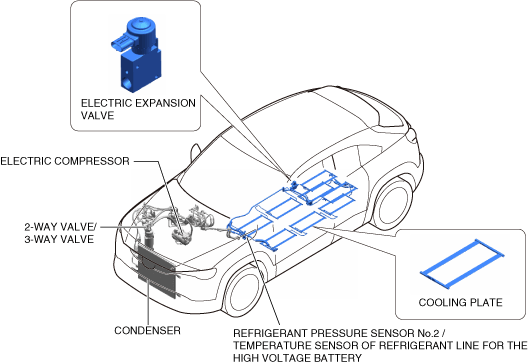HIGH VOLTAGE BATTERY COOLING SYSTEM
id304100100200
Outline
• The high voltage battery releases thermal energy when charging and discharging electrical power. To cool the high voltage battery, refrigerant is circulated inside the high voltage battery.
Additionally, using the high voltage battery at the appropriate temperature allows efficient charging and discharging and prevents the battery performance from deteriorating due to heat.
• The high voltage battery cooling system expands a high-temperature, high-pressure refrigerant through the electric expansion valve of the high voltage battery, and circulates the converted low-temperature and low-pressure refrigerant in the cooling tube to cool the high voltage battery.
Structure
• The battery cooling system consists of the following parts.
|
Part name
|
Reference
|
|
Electric expansion valve
|
|
|
Cooling plate
|
|
|
Refrigerant pressure sensor No.2
|
|
|
Temperature sensor of refrigerant line for the high voltage battery
|
Construction
• The cooling plates are installed underneath the high voltage battery modules. By integrating the cooling plates with the high voltage battery modules, cooling performance is improved.
• By passing low temperature and low pressure refrigerant through the cooling tubes, the cooling plates are cooled which cools the battery modules.
• The low temperature/low pressure refrigerant atomized by the electric expansion valve is distributed by the distributor installed to the pipe inlet. Refrigerant distributed in 2 directions cools the cooling plates by circulating through the cooling tubes to cool the battery modules.
• The high voltage battery can be cooled uniformly and efficiently by dividing the cooling passage into 2 systems arranged parallel to each other. Additionally, it reduces the pressure loss in the cooling passages.
Flow Chart
Operation
• With the high voltage battery cooling system, the BECM, PCM and heat pump control unit input drive signals to each actuator based on information from each sensor, and perform high voltage battery cooling control For the control details, refer to [HIGH VOLTAGE BATTERY COOLING CONTROL].(See
HIGH VOLTAGE BATTERY COOLING CONTROL.)
